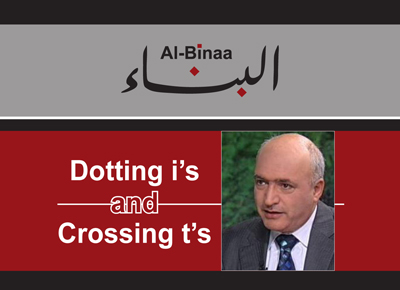
September 26, 2024
Nasser Kandil
In the shadow of discussions within the entity about the possibilities of a land operation on the Lebanese front, and in parallel, between its leaders and Washington, in the course of which the Pentagon has said, and even declared, that it does not see the occupation’s army ready for such a war given the results of its war on Gaza, another discussion is taking place about the possibility of a war on cities and infrastructure and the risks it entails of Hezbollah displaying arsenal still robust, by the admission of high-ranking entity military officers, and the brandish of strategic weapons especially, with lethal fire reaching the entity’s deep interior. The American’s declared warning about not targeting Lebanese infrastructure is motivated by fear for the entity and not love for Lebanon, given that the American has not pronounced a syllable about the massacres committed by the entity against Lebanon and the Lebanese, and no talk about political initiatives, which Benyamin Netanyahu has said he is open to, can be viewed except as a safety plank extended by the American.
It is the same dilemma which was pressing on the entity in July before Netanyahu’s visit to Washington, in the background of which was the American-Israeli failure to solve the intractable problems created by
Al Mukawama Axis, making the only exit the acceptance of Gaza’s Mukawama (Resistance) conditions with a formula which ends the war and guarantees full withdrawal from Gaza, and the exchange of prisoners. This came after the American failure to resolve the intractable problem of the Red Sea by force, and the occupation failed to resolve the problems of the prisoners and of the displaced from the northern settlements by force. Enter the American invigorating gifts to the entity through the schemes for the assassinations of the two Commanders, Ismail Haniyeh and Fuad Shukr in Tehran and Beirut, to regain the image of power, and the rush to open negotiations to block responses from Iran and Lebanon under the pretext of the presence of an opportunity for ending the war on Gaza, after capitalizing on disruption and unsettlement in Hamas with the assassination of her leader, and placing pressure on Hamas’ milieu to accept what will not cause embarrassment to the entity. Half of the scheme failed when Hamas unanimously elected Commander Yahya Sinwar as leader, who in turn placed firms limits on the negotiations, and the second half fell when Hezbollah targeted the headquarters of Unit 8200 north of Tel Aviv, accomplishing fatal hits, resulting in the entity’s leaders coming out and declaring their disregard of war, with the entity again returning to the same dilemma.
The American gifts continued with a lethal bundle composed of the triple detonation of the pagers, walkie-talkies and the assassination of Commander Ibrahim Akeel and a number of Al Radwan commanders, and were crowned with the knockout of airstrikes on the south and the Bekaa’, seeking Hezbollah’s faltering, to open up the path for Lebanese acceptance of disengagement between the fronts of Lebanon and Gaza. Hezbollah, however, absorbed the shock and blows, and quickly stood up on both feet, doubling the activation of the supportive web, followed by the response to the assassination through qualitative strikes on the north and south of Haifa, and set in motion the formula of doubling the number of displaced. When the entity’s leaders talked about destroying Hezbollah’s missile capabilities, particularly strategic, high ranking military commanders came out denying and disowning such bombastic claims, saying that Hezbollah’s missile and strategic capabilities remain intact, and their strategic missiles are stored in locations unknown to the military to claim their destruction. The gifts ended, and the entity went back to the dilemma.
The Kader 1 missile sent to Tel Aviv and the strike on settlements resulting in injured civilians said that Hezbollah has activated former formulas, Tel Aviv for Al Dahieh (Beirut’s southern suburb) and civilians for civilians, and far greater will be forthcoming. In discussing the option of the land operation, talk about the formulation of an American initiative emerged, based on a concurrent and inseparable ceasefire on both of Lebanon’s and Gaza’s fronts, opening the door for agreement on implementation of UN Resolutions 1701 and 2735 within 4 weeks, where the entity agrees to the UN framework in Gaza because of needing it need for Lebanon, and accepts the text of UN Resolution 2735. What the entity knows is that 2735 includes full withdrawal from Gaza and the acceptance of a UN resolution calling for a Two-State solution and the creation of a Palestinian State, while 1701 includes ending violations of Lebanese air space and withdrawal from occupied Lebanese areas. Additionally, in the event the entity refrains from execution, the commitments on Hezbollah’s side will similarly not be executed.
Has the entity reached the point of weakness to accept the unity of fronts, or will it go to the ground war? The answer is that Al Mukawama has no need for prediction, and is prepared for both probabilities, and confident of victory in both.



